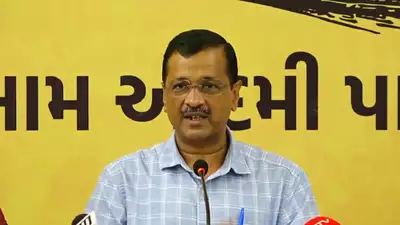
Why Gujarat is key to AAP’s dream of becoming a national party

The Aam Aadmi Party (AAP) appears undeterred by the prediction of pollsters that the party may not create any big surprise in the upcoming state legislative assembly elections in Himachal Pradesh and Gujarat.
Unperturbed, it is going the whole hog in the two states with a larger goal: not to form the government. If it can come to power, it would only be a bonus since its ultimate objective is to join the elite club of eight national parties ahead of the 2024 general elections.
This goal is within AAP’s striking distance since all it needs to do is to ensure that it polls at least 6 per cent votes in any of these two states. If the opinion polls are a yardstick to go by, AAP might not be able to make a big dent in Himachal politics as it is projected to barely manage to open its account in the 68-seat Himachal Pradesh assembly.
The party’s hopes largely hinge on Gujarat where it has managed to create a base for itself and demonstrated it as well by polling 13.28 per cent votes during the February 2021 civic body elections. Opinion polls have predicted that the party could win between 18 and 24 seats in the 182-member Gujarat assembly by polling about 28 per cent votes.
National party norms
The Election Commission of India (ECI) recognises eight political outfits as national parties. They include the Bharatiya Janata Party (BJP), the Indian National Congress (INC), the Communist Party of India (CPI), the Communist Party of India-Marxist (CPM), All India Trinamool Congress (TMC), Bahujan Samaj Party (BSP), the Nationalist Congress Party (NCP) and the National People’s Party (NPP).
According to the Election Commission rules, a registered party can be recognised as a national party only after it fulfils any of the three laid down conditions: it wins 2 per cent seats in Lok Sabha from a minimum of three states; polls 6 per cent votes in a minimum of four states, or if it is recognised as a state party in four states.
The National People’s Party, essentially a Meghalaya-based regional party, has benefited from this rule; despite having one MP each in Lok Sabha and Rajya Sabha, it became a national party in 2019 after it got recognised as a state party in four Northeast states.
AAP is already recognised as a state party by the Election Commission in three states — Delhi, Punjab and Goa. Gujarat, thus, holds the key for AAP supremo Arvind Kejriwal’s ambitious plans to go national.
Also read: BJP spent 6300 crore on toppling govts of other parties: Kejriwal
Beyond status symbol
Becoming a national party is more of a status symbol although national parties do enjoy certain benefits like having a permanent symbol across the country, getting a government bungalow in New Delhi for its national president and office space at a subsidised rate in the national capital. AAP does not require these since it has its office at Rouse Avenue in New Delhi and Kejriwal lives in a big government bungalow in Civil Lines (north Delhi) by virtue of being the Delhi chief minister.
Unlike NPP, getting recognised as a national party is not just a status symbol for AAP. It intends to add more visible muscle to its stature to keep itself in good stead for the 2024 general elections, and if possible, topple the Congress party from the rank of being the principal opposition party in Parliament.
Currently, it is at par with the Congress party since both parties are in power in two states each. A national status will give AAP more tools to negotiate if Kejriwal changes his mind and decides to join the proposed joint opposition front to take on the BJP in the 2024 Lok Sabha elections.
Also read: How Kejriwal managed to turn Gujarat into an AAP vs BJP contest
Kejriwal’s national ambitions
That Kejriwal harbours prime ministerial ambitions is no secret. However, he will have to jostle ahead of some prominent leaders of other opposition parties to be projected as the joint opposition’s prime ministerial face. The prospective prime ministerial faces include senior Congress leader Rahul Gandhi, and three chief ministers – Mamata Banerjee (West Bengal), Nitish Kumar (Bihar) and K Chandrasekhar Rao (Telangana).
Kejriwal has already announced that AAP would not be part of the proposed grand national alliance of the opposition parties, which has been in the making for the past year-and-a-half.
Kejriwal’s plan is simple and clear. He likes to be his own boss. Since he would not accept anyone else as his leader, AAP would prefer going solo if Kejriwal is not named the joint opposition’s leader.
Instead, Kejriwal would prefer working towards strengthening his party in various states, hoping that India elects a hung Parliament in 2024 and the opposition requires AAP’s support to form the next government at the Centre. This is where he can negotiate from the position of strength for the prime minister’s post and fulfil his national dream.


